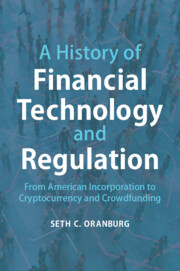 A History of Financial Technology and Regulation
A History of Financial Technology and Regulation from The Second Era
Published online by Cambridge University Press: 24 March 2022
This Chapter examines the American economy during World War II, with a particular focus on the emergence of computer technologies and its impact on financial markets. The Investment Company Act of 1940 originally sought to regulate “actively managed” mutual funds; soon, however, computer technology enabled a new financial product, the “passively managed” fund. Investment advisors increasingly were replaced by computers that managed and balanced funds more rapidly and efficiently. Computer-managed index funds that trade based on a static algorithms are not subject to the typical agency problems that arise when humans make decisions on behalf of others. However, algorithms may be subject to bias when their code is created by imperfect human beings. Software is only as good as its design. This technology spawned a host of new risks. Algorithms failed spectacularly in instances such as the Flash Crash. In response, regulators instituted new securities regulations, including Regulation NMS .Computers networked on the new internet helped the American economy recover from yet another financial crisis as public attitude towards corporations and “Trickle-Down Economics” began to sour.
To save this book to your Kindle, first ensure [email protected] is added to your Approved Personal Document E-mail List under your Personal Document Settings on the Manage Your Content and Devices page of your Amazon account. Then enter the ‘name’ part of your Kindle email address below. Find out more about saving to your Kindle.
Note you can select to save to either the @free.kindle.com or @kindle.com variations. ‘@free.kindle.com’ emails are free but can only be saved to your device when it is connected to wi-fi. ‘@kindle.com’ emails can be delivered even when you are not connected to wi-fi, but note that service fees apply.
Find out more about the Kindle Personal Document Service.
To save content items to your account, please confirm that you agree to abide by our usage policies. If this is the first time you use this feature, you will be asked to authorise Cambridge Core to connect with your account. Find out more about saving content to Dropbox.
To save content items to your account, please confirm that you agree to abide by our usage policies. If this is the first time you use this feature, you will be asked to authorise Cambridge Core to connect with your account. Find out more about saving content to Google Drive.